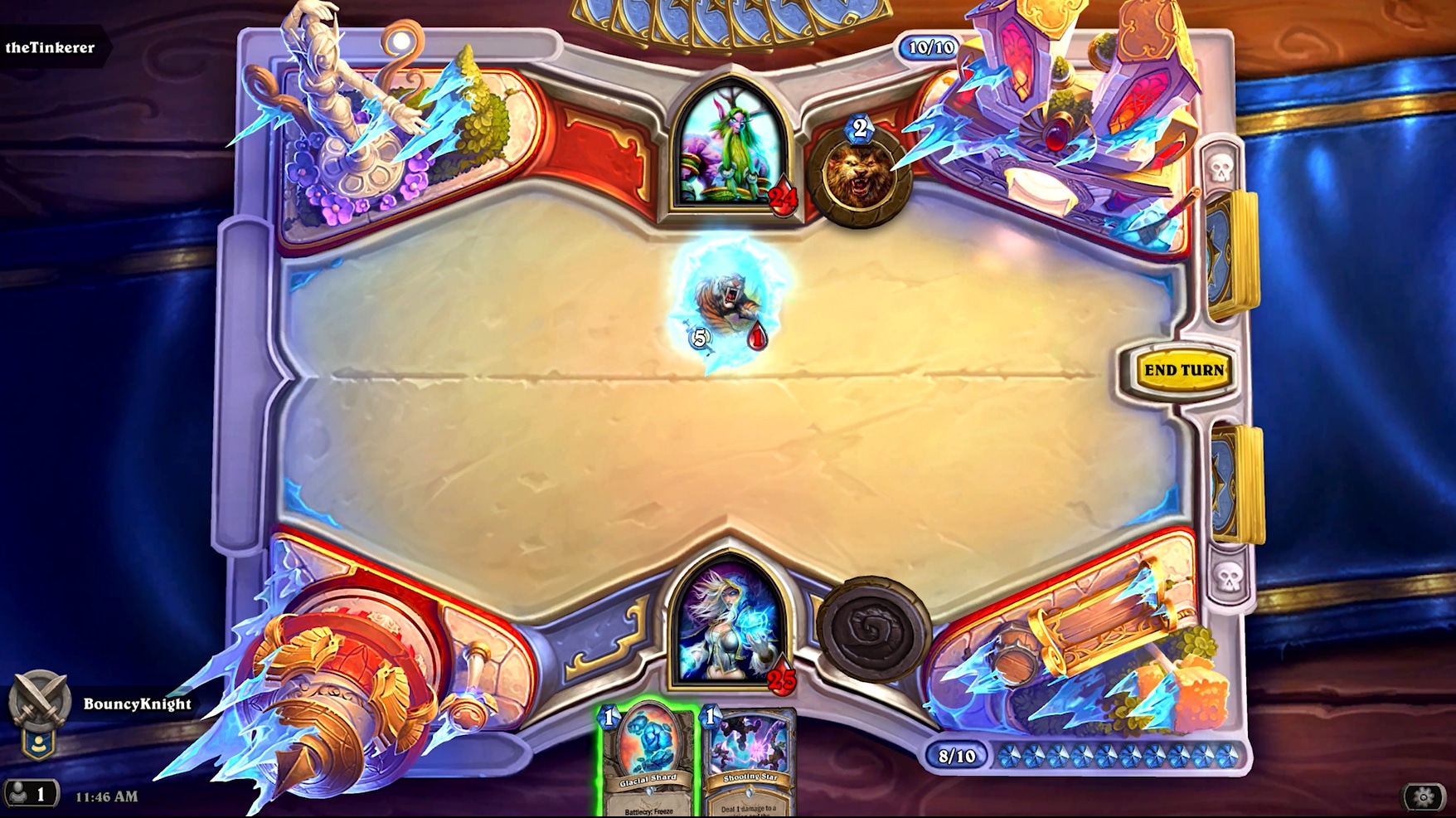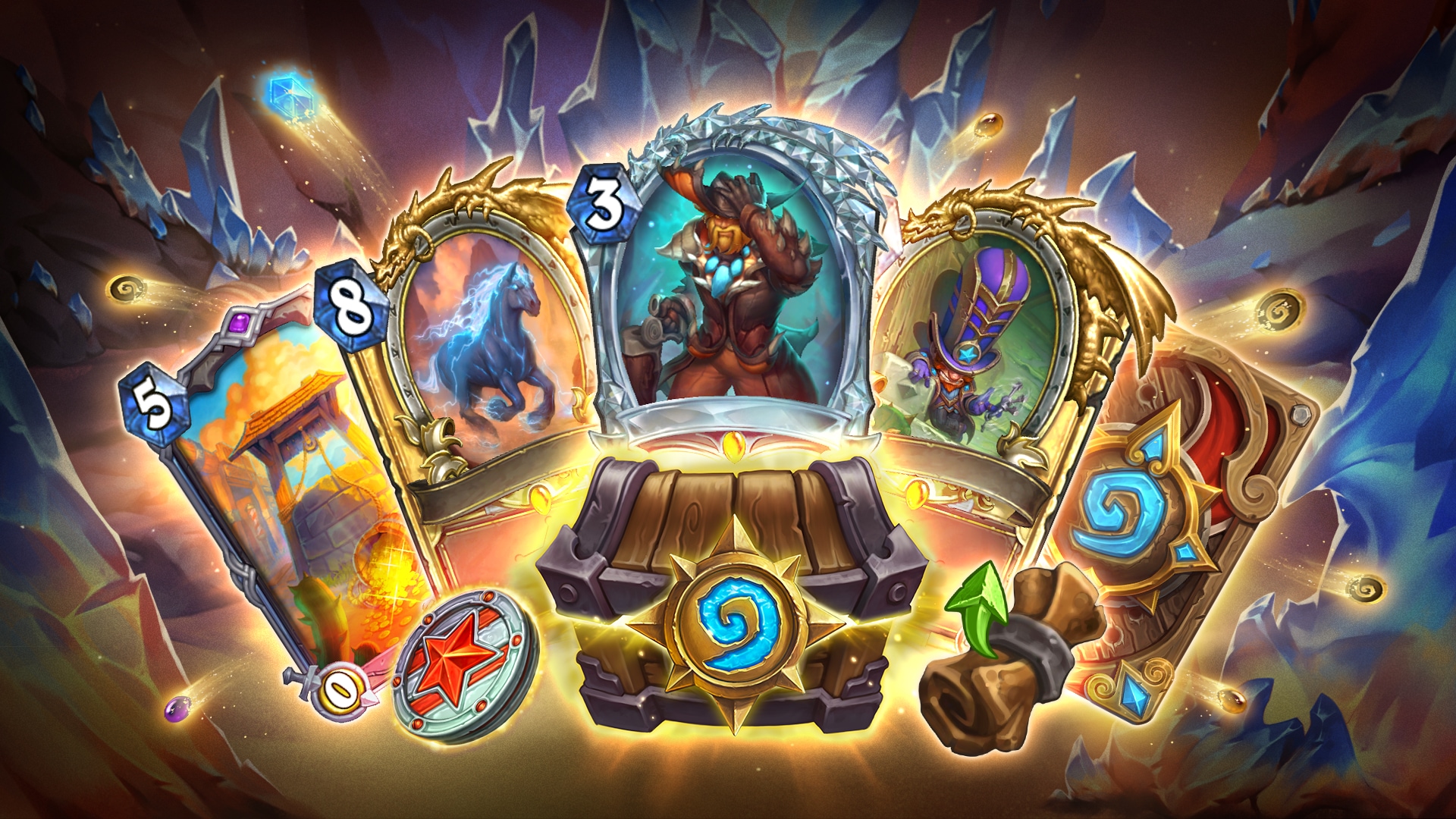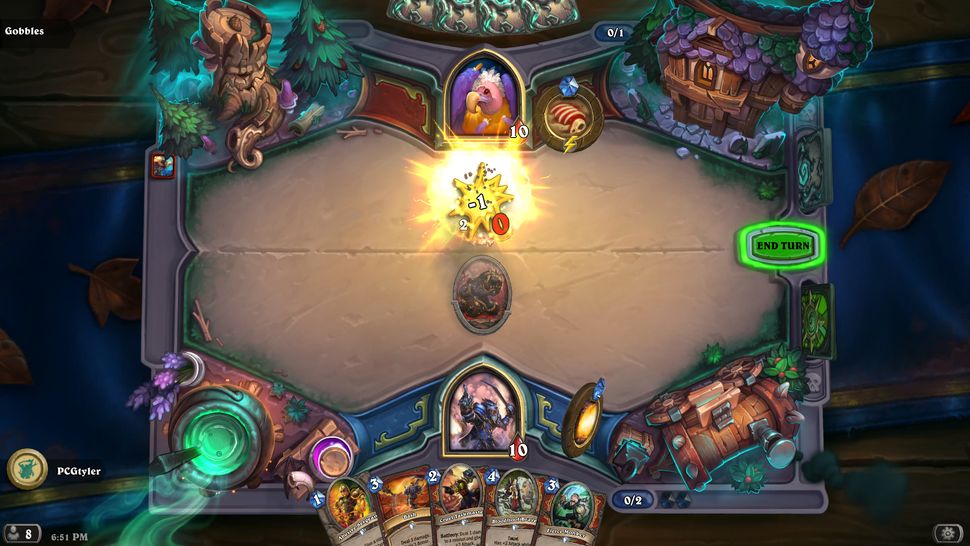After Hearthstone's open beta launch in 2014, we published our first review of the game. Since then, Blizzard's CCG has undergone substantial changes, prompting us to reevaluate it. You may still read our initial evaluation by going here. Go here to learn more about the reasons for our decision to re-review these games.
It would be easy to begin this review with a story about a time when Hearthstone's infamous RNG decided a game for me. I could easily remember three Arcane Missiles hitting my face, which I had assumed was protected by a whole board of potential targets. Alternatively, I may choose a scenario where I overcame adversity by getting the one card that could save me from an otherwise bleak situation. I might also discuss how exciting it was to pull the top two Legendaries out of my first five packs in a new set, or how I once despite having the ideal deck, lost three straight games due to ridiculously bad draws in the Arena. However, focusing only on Hearthstone's most amazing moments would take away from what makes the game unique, therefore I don't want to do that.It has always been about the larger picture for me. Although it is clearly appealing to witness egregiously implausible situations happen, Hearthstone provides me with more enjoyment when I observe such scenarios. unfold hundreds of times to achieve variance equivalency. As soon as it occurs, the most popular meta-matchups appear as infinitely long probability trees. Talking about RNG in Hearthstone as something that is essentially disruptive is simple, but in practice, it's just another item to consider when making plans. Reaching the stage where your plays are dictated by the inherent chance of the game, instead of being impeded by it, is the mark of a true Hearthstone player.
Greetings!
VIDEOS THAT ARE SUGGESTED FOR YOU...
For a moment, let's step back from the high-level details. Blizzard created the strategy game Hearthstone, which was made available in 2014. Although it wasn't the first collectible card game (CCG) to be made for the PC, it was the one that caused the genre to take off online. These days, there are a lot of copycats trying to share the same level of success. The Elder Scrolls: Legends, Gwent, and Valve's upcoming game Artifact are among the most prominent ones. With that said, Hearthstone is still the leader in digital collectible card games even though it isn't quite the monolith it once was. And with good cause. The main reason for Hearthstone's success is that its fundamental concepts are kept basic enough for new players to not feel completely out of their element right away, but they also leave just enough intricacy to keep you interested in the long run.
The tutorial, which consists of six (easy) challenges against AI opponents and has mostly not changed since its introduction, is how new players are introduced to the game. Depending on the player's degree of CCG expertise, this may or may not be very helpful. Even though I had played a lot of Magic: The Gathering before, I thought it was instructional; nonetheless, I understand that some people would rather play the main game without having to deal with it.
Every interaction is dripping with refinement and elegance, from the eye-catching Legendary entrance effects to the card-draw animations.
The instruction kept me interested since it was so interesting to witness the exquisite rendering of the cards and their interactions. Spells explode with vibrant effects that heighten the satisfaction when you aim them directly at your opponent's face. The creatures you play on the board are called minions, and they all have distinct, frequently humorous lines of speech that they blurt out when you summon them, when they attack, and when they die. The game board trembles dramatically as you dome the opponent player with a gigantic minion. The majority of people imagine that card games are more about the rules than the presentation, and that's what makes them fun. That is not how Hearthstone works. Every interaction is dripping with refinement and elegance, from the eye-catching Legendary entrance effects to the card-draw animations.
The game board itself is filled with various oddities and curiosities (referred to by players as "clickers") that add to the overall sense of pleasure and uniqueness. It's a thoughtful addition. Holding off until your rival takes a long turn can be frequently really boring, so being able to stoke a volcano or grow vegetables is excellent.
Every interaction is dripping with refinement and elegance, from the eye-catching Legendary entrance effects to the card-draw animations.
The instruction kept me interested since it was so interesting to witness the exquisite rendering of the cards and their interactions. Spells explode with vibrant effects that heighten the satisfaction when you aim them directly at your opponent's face. The creatures you play on the board are called minions, and they all have distinct, frequently humorous lines of speech that they blurt out when you summon them, when they attack, and when they die. The game board trembles dramatically as you dome the opponent player with a gigantic minion. The majority of people imagine that card games are more about the rules than the presentation, and that's what makes them fun. That is not how Hearthstone works. Every interaction is dripping with refinement and elegance, from the eye-catching Legendary entrance effects to the card-draw animations.
The game board itself is filled with various oddities and curiosities (referred to by players as "clickers") that add to the overall sense of pleasure and uniqueness. It's a thoughtful addition. Holding off until your rival takes a long turn can be frequently really boring, so being able to stoke a volcano or grow vegetables is excellent.
It's free to play, incidentally.
The production values are excellent, but let's talk about the bigger picture: How are these things paid for? Yes, Hearthstone allows you to purchase card packs. Yes, investing money is the greatest method to gain access to all of the top competitive decks. It is possible to play for free; daily missions can net you about 150 gold each day, and you can also get extra by grinding the Ladder and Arena (more on both later). However, this is a long-consuming grind that requires a significant investment of time. Additionally, Blizzard has been giving out more free packs with every new set and card prize after every season—these have less impact on mitigating the effects of a content delivery schedule that has accelerated over time. Naturally, this is all done on purpose. The Hearthstone business model depends on players wanting to update their collections whenever a new set is released; if this could be done easily enough without charge, then no one would ever purchase packs.
Variety is the major thing that users of free-to-play will lose out on. A budget can nevertheless allow one to achieve high ranks, considering that in nearly every metagame In Hearthstone's history, a low-cost deck can rival the elite players. With a little grinding and careful use of the crafting system, you can make it, but how long before you become tired of using the same deck? Matching up with decks full of dazzling Legendaries can be somewhat frustrating, especially if all of your cards seem like things a player in World of Warcraft might need to kill ten of to complete a quest.
Variety is the major thing that users of free-to-play will lose out on. A budget can nevertheless allow one to achieve high ranks, considering that in nearly every metagame In Hearthstone's history, a low-cost deck can rival the elite players. With a little grinding and careful use of the crafting system, you can make it, but how long before you become tired of using the same deck? Matching up with decks full of dazzling Legendaries can be somewhat frustrating, especially if all of your cards seem like things a player in World of Warcraft might need to kill ten of to complete a quest.
Additionally, I would contest the idea that card games must use this particular business model. In the digital realm, the precedent that paper CCGs have established is no longer necessary. However, there are some distinct benefits. For example, most players may now enjoy themselves to the fullest without having to spend any money, which would not be feasible if whales on the other end of the spectrum weren't supporting them. Nevertheless, a lot of those players would have a sense of estrangement due to perceived disparities in wealth between themselves and their rivals. It's difficult to strike the right balance, just like in a lot of Hearthstone.
Personally, I'd much rather be able to purchase the game and unlock every card in the collection for a fixed price. This is the approach that Valve's next CCG, Artifact, claims to take. To be honest, it excites me. The freemium business model of Hearthstone is not without its benefits, but the majority of these will go to those who play the game less frequently. Players who are more competitive—among which I would include myself—don't gain as much.
Using your cards correctly
Despite its critics, Hearthstone is still a complex and rewarding strategy game, which is the secret to its ongoing popularity. Another major factor that keeps it entertaining despite certain annoying metas is its capacity to update itself with new Keywords and, in the case of Quests and Death Knights, even completely new sorts of cards. Even after four years of playing, I still don't feel like I've mastered every element. It involves a lot of deckbuilding, which offers more than 1,500 cards and nearly endless options across nine classes. Even the best players take a very long time to figure out the most optimized decks following the release of a new expansion, even though the vast majority of those options obviously won't make for a strong competitive deck (although mileage may vary depending on one's definition of fun). As previous game director Ben Brode noted in his most recent PC Gamer interview, completely new archetypes are frequently discovered just weeks before the release of the next expansion.
The mechanics are also more intricate once in-game than is frequently acknowledged. It's inevitable that many of these interactions and mechanisms will be found in most CCGs: making reads on your opponent's hand, assessing the likelihood that a play will be successful, and effectively utilizing your resources are all examples of components that fall into this category. You will need to master a lot of things if you are a total beginner to CCG. Throughout the first few games, for instance, it becomes clear how important it is to play your cards to meet your mana curve. Another is to use your opponent's removal spells as bait before using your game-winning minion. And so forth. constantly seem like such a wonderful thing. Sometimes, on your four-mana turn, you're left thinking about your hand full of three-cost cards since your opponent simply has the most effective minions for their mana each turn. This is the kind of scenario that makes the game seem like "Curvestone"—you feel that the choices you make are superseded by the value of a strong deck and a favorable draw.
Another way that Hearthstone sets itself apart from paper counterparts is with a variety of card effects that are exclusive to video games. The individual who constantly seem like such a wonderful thing. Sometimes, on your four-mana turn, you're left thinking about your hand full of three-cost cards since your opponent simply has the most effective minions for their mana each turn. This is the kind of scenario that makes the game seem like "Curvestone"—you feel that the choices you make are superseded by the value of a strong deck and a favorable draw.
Another way that Hearthstone sets itself apart from paper counterparts is with a variety of card effects that are exclusive to video games. The individual who played a Mage'secret' against a class rival. Spells known as secrets are those that, when cast, show up as question marks beneath the player's portrait. Until the prerequisite is met, you are unable to identify what a secret spell is. Nevertheless, I was able to persuade myself during the game that Ice Block, a card that prevents death the first time a player takes lethal damage, must be the answer. As a result, I missed multiple chances to kill him because I believed the Ice Block would stop me and I would lose. He finally moved into a favorable position where I could take advantage of the way the game was going.lacked even the means to set off an Ice Block. I was defeated. I questioned him about the Secret after the game. Spellbender, not Ice Block, was what it was. I had successfully tricked myself out of a victory by trying to read too much into what his card was.
The mechanics are also more intricate once in-game than is frequently acknowledged. It's inevitable that many of these interactions and mechanisms will be found in most CCGs: making reads on your opponent's hand, assessing the likelihood that a play will be successful, and effectively utilizing your resources are all examples of components that fall into this category. You will need to master a lot of things if you are a total beginner to CCG. Throughout the first few games, for instance, it becomes clear how important it is to play your cards to meet your mana curve. Another is to use your opponent's removal spells as bait before using your game-winning minion. And so forth. constantly seem like such a wonderful thing. Sometimes, on your four-mana turn, you're left thinking about your hand full of three-cost cards since your opponent simply has the most effective minions for their mana each turn. This is the kind of scenario that makes the game seem like "Curvestone"—you feel that the choices you make are superseded by the value of a strong deck and a favorable draw.
Another way that Hearthstone sets itself apart from paper counterparts is with a variety of card effects that are exclusive to video games. The individual who constantly seem like such a wonderful thing. Sometimes, on your four-mana turn, you're left thinking about your hand full of three-cost cards since your opponent simply has the most effective minions for their mana each turn. This is the kind of scenario that makes the game seem like "Curvestone"—you feel that the choices you make are superseded by the value of a strong deck and a favorable draw.
Another way that Hearthstone sets itself apart from paper counterparts is with a variety of card effects that are exclusive to video games. The individual who played a Mage'secret' against a class rival. Spells known as secrets are those that, when cast, show up as question marks beneath the player's portrait. Until the prerequisite is met, you are unable to identify what a secret spell is. Nevertheless, I was able to persuade myself during the game that Ice Block, a card that prevents death the first time a player takes lethal damage, must be the answer. As a result, I missed multiple chances to kill him because I believed the Ice Block would stop me and I would lose. He finally moved into a favorable position where I could take advantage of the way the game was going.lacked even the means to set off an Ice Block. I was defeated. I questioned him about the Secret after the game. Spellbender, not Ice Block, was what it was. I had successfully tricked myself out of a victory by trying to read too much into what his card was.
A little different is Arena. It requires payment upon entry (either 150 gold or real money), unlike Ladder. Similar to Magic: The Gathering's Limited format, you draft your deck by selecting three cards at a time from the deck that is presented to you. You then compete against other players who have made the same decisions. You play until you either win 12 times or lose 3 times, and based on how many victories you totaled, you'll receive a prize at the conclusion. Due to the lack of any form of deck requirement, arena games tend to draw in new players. Additionally, I picture it self- In contrast to ladders, which can be frightening to jump into when everyone seems to be using incredibly effective decks that they've copied from the enormous collection of "net decking" websites, contained nature is less intimidating.
It's obvious that Hearthstone won't go out of style anytime soon. Even while it currently has competitors, none of them can even come close to challenging Blizzard's hegemony. It's also easy to forget that Hearthstone has a firm grip on the digital collectible card game market for very solid reasons. One game that came along and brought some really fascinating mechanical advances to the table but fell short when it comes to flavor and visual design is Elder Scrolls: Legends. That material is crucial, and Hearthstone excels at providing it.by far more than any other card game. Four years after its release, the game's polish and sufficient depth for the majority of players make it an even more alluring prospect. Therefore, if you haven't tried it yet, this is the perfect time to do so. I don't want to be buddies with you if you play Priest.










.jpg)
.jpg)

.jpg)
.jpg)
.jpg)
.png)

.jpeg)



0 Comments